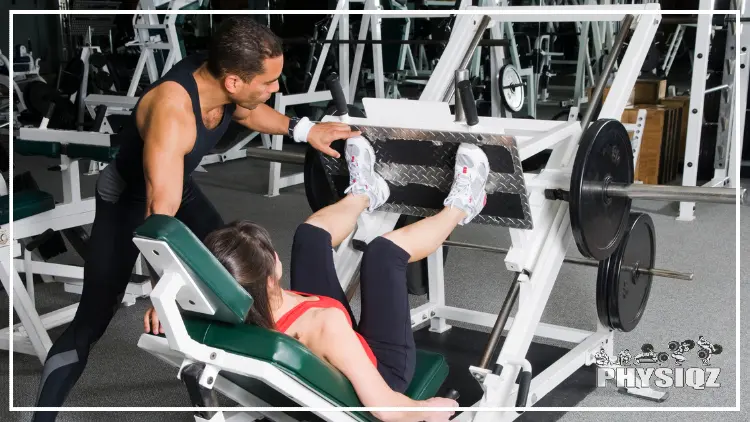
On the leg press, foot placement makes all the difference when targeting the quads vs the glutes so we tested 9 different foot positions to conclude which is the winner for each muscle group.1, 2
With this information at your disposal, you’ll be able to use the leg press to maximize muscle growth and strength, while reaping the benefits of this seated exercise that’s great for back safety and stability because it doesn’t load the spine (unlike squats).
The Importance of Leg Press Foot Placement
Though most people are taught a standard foot placement on the leg press foot plate, altering foot positions can give someone a completely different muscle workout with only slight adjustments.
One’s foot placement on leg press is more important than they may realize; a certain foot placement could drastically increase knee flexion and emphasize the quads, while another might heighten hip flexion instead and give the glutes and hamstrings more of a workout. 3
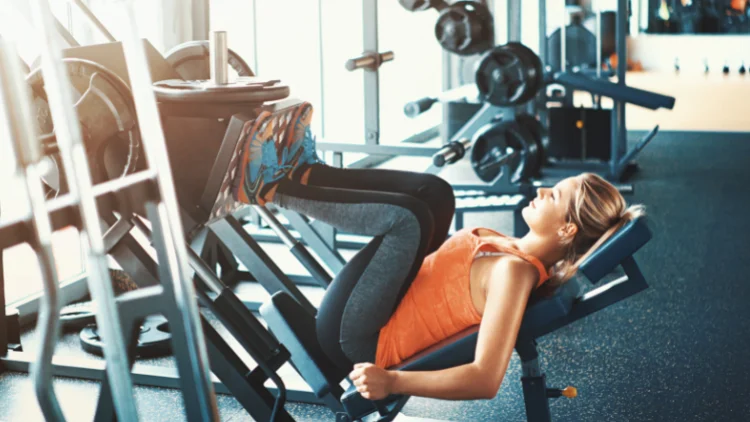
Source: gilaxia via Canva.com4
For beginners embarking on strength routines and wondering why they’re gaining strength without size, consider adjusting the foot placement on the leg press to potentially accelerate muscle growth.
However, anyone experimenting with new foot positions should know the ins and outs of each because some should be used sparingly or at least be balanced out with others so as not to cause any injuries or overwork certain muscles.
The effects on the knees during squat and leg press exercises highlight the fact that squats can exacerbate any previous knee injuries, but the leg press seems to be much safer and gentler on the knees with proper foot placement.
This may be due, in part at least, to the smaller range of motion made possible on the leg press in particular foot positions.5
Rest assured that increasing the range of motion of the knee isn’t necessarily a bad thing, but fatiguing or hyper stretching the knee (or any other muscle, for that matter) can lead to pain or injury–another reminder that rotating between various foot placements to work a variety of muscles is key.6
The leg press exercise is beginner-friendly, doesn’t require balance like squats and other standing leg workouts, and allows the lifter to move a lot of weight and strengthen many different muscles at once.
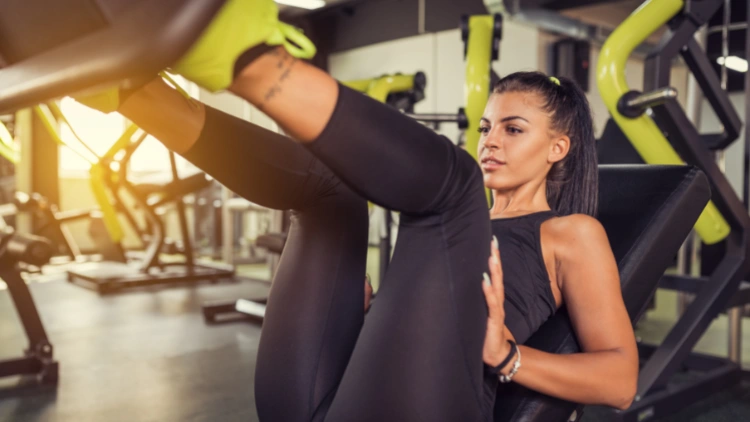
Source: bulatovic via Canva.com7
Although all foot placement variations will work the glutes, hamstrings, quads, and calves somewhat, certain placements target specific muscles to a much higher intensity and with much greater precision, which can expedite hypertrophy (building muscle) and increased strength; let’s see which placements focus on which muscles.
9 Leg Press Foot Placements & Their Impact on Muscles (Advantages & Disadvantages of Each Position)
While some may believe that muscle activation during leg press exercises is consistent, even minor adjustments in leg press foot placement can significantly impact the targeted leg muscles and their engagement levels.8
Athletes who follow powerlifting hypertrophy programs or other powerlifting and power-building routines are likely familiar with the leg press and its targeted muscle groups. However, both novices and experienced lifters could benefit from reviewing how different foot placements can target specific muscles.
1. Standard Foot Placement
- Muscles Targeted: Quads, glutes, and hamstrings
- Pros: Most commonly taught, good for beginners and pros alike
- Cons: More of a generalized leg workout, no specific muscle targeted
2. High Foot Placement
- Muscles Targeted: Hamstrings, glutes
- Pros: Works entire posterior chain; great alternative to deadlifts or hamstring curls
- Cons: Quads largely neglected in this stance
3. Low Foot Placement
- Muscles Targeted: Quads, calves
- Pros: Strong quad emphasis
- Cons: Should be avoided by anyone with weak knees or previous knee injuries
4. Wide Foot Placement
- Muscles Targeted: Abductors, glutes, and hamstrings
- Pros: Strong glute emphasis
- Cons: A lot of adductor flexibility needed
5. Narrow Foot Placement
- Muscles Targeted: Quads
- Pros: This stance allows for more weight to be moved
- Cons: Drastically restricts range of motion
6. Standard w/ Elevated Heels Foot Placement
- Muscles Targeted: Quads, calves
- Pros: Tones quads, strengthens calves
- Cons: Requires “prop” to elevate (inconvenient); fairly unnatural position and should be used sparingly–other foot placements work quads more than enough
7. Standard w/ Elevated Toes Foot Placement
- Muscles Targeted: Hamstrings
- Pros: Strong emphasis on hamstrings
- Cons: Requires “prop” to elevate; hamstrings worked plenty with other stances
9. High & Wide Foot Placement
- Muscles Targeted: Glutes, hamstrings, and hips
- Pros: Brings hips into play
- Cons: Quads lose some movement
9. Low & Narrow Foot Placement
- Muscles Targeted: Quads
- Pros: Quads get an intense workout
- Cons: Puts a lot of strain on the knees; avoid if prone to knee pain or injuries
1. Standard (Shoulder Width) Basic Foot Placement
Starting with the foot placement that is most commonly taught and used, this is often called the “standard”, “basic”, or “neutral” stance on the leg press.
With feet shoulder width apart and centered on the foot plate, this position is good for all around leg development and works every muscle fairly equally, with the quads usually getting just slightly more attention than the glutes and hamstrings.
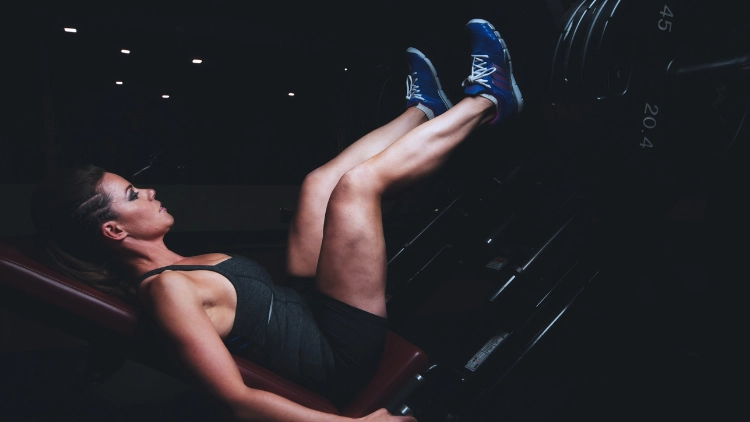
Source: Scott Webb from Pexels9
The standard foot placement is recommended for beginners but can certainly be used by lifters of all experience levels for an overall or generalized leg workout. However, for those wanting to really hone in on certain muscles, the basic stance may not be the best bet.
2. High Foot Placement
High foot placement heightens the amount of hip extension and decreases the knee’s range of motion, which in turn creates more tension in the glutes and hamstrings. This gives these muscles a more intense workout and strengthens both the hamstrings and glutes at a faster rate if done properly.
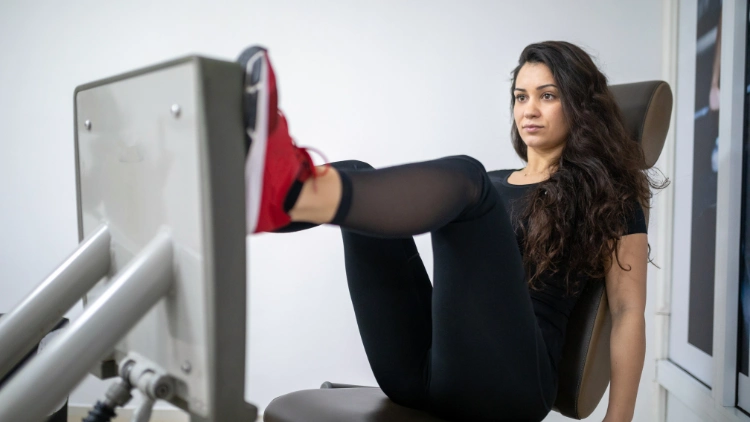
Source: Dusan Ilic Canva.com10
While increasing hip flexion and extension and really working the posterior chain, the high foot placement decreases the knee’s range of motion and mostly excludes quads.
3. Low Foot Placement
Placing one’s feet lower on the leg press unsurprisingly has the opposite effect of the high foot placement. Instead of increasing hip extension, the lower foot placement reduces hip flexion and extension and instead allows for more movement through the knee.
Those performing the low placement will experience more quad and calf engagement instead of targeting hamstrings and glutes.
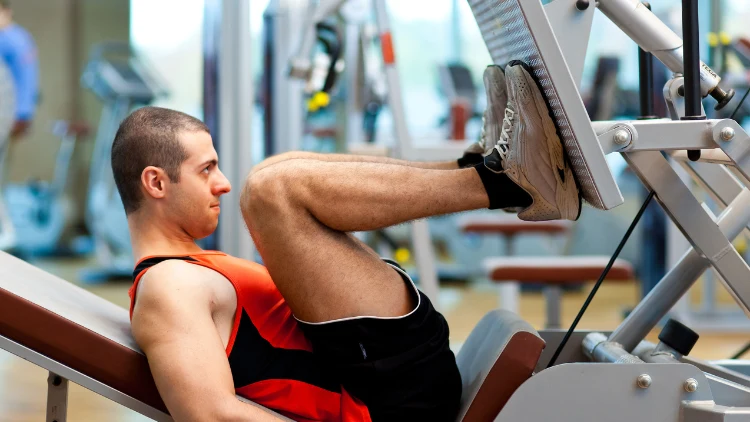
Source: Minerva Studio via Canva.com11
One risk to look out for with the low foot placement is knee injury; with a greater range of motion and therefore increased knee extension and flexion, the knee will take more of a beating than in the higher foot placement.12
That does not mean low foot placements should be completely avoided on the leg press, but anyone attempting this placement should do so in moderation and with safety precautions in mind while those with current or pre-existing knee pain or knee injuries may want to avoid this particular foot placement altogether.
For anyone else who is not concerned about knee issues, this is actually one of the best foot placements for maximizing strength and hypertrophy through the quads.
4. Wide Foot Placement
A wide foot placement on the leg press, at about 1.5x shoulder width apart, concentrates on the glutes, abductors, and hamstrings. While toes should usually be mostly vertically aligned in leg press workouts, in a wide stance it may be more comfortable to angle one’s toes just slightly outward.
Glutes are very much engaged when the hips are more open in this wider stance but abductors and hamstrings are hit hard as well, making this a good foot placement for anyone who is wanting to work a few muscles simultaneously.
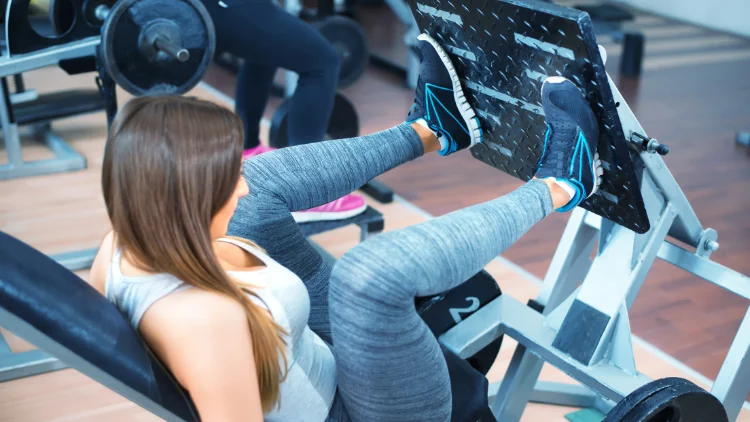
Source: bluecinema via Canva.com13
Inner thigh flexibility will have the final say on how wide of a stance is comfortable for each person, so those trying the wide foot placement should experiment and see what feels right.
Width between your feet doesn’t have to be exactly 1.5x shoulder width apart so feel free to make slight adjustments based on preference or comfort, but everyone using the leg press machine should be cautious not to let their feet get too close to the edge of the sled or foot plate–especially while in a wide stance–as a small slip can easily cause a major injury.
5. Narrow Foot Placement
A narrow foot placement means bringing your feet just a little closer together than shoulder width apart. With the feet close but not quite touching, this narrow stance is the definition of quad-centric as range of motion is minimized and quads are targeted as much as they possibly can be.
For an added challenge and to really feel the burn and activate gains and growth on the leg press, one should go as deep as possible while in the narrow foot placement.
However, it is vital to keep both feet flat on the sled and to continue pushing down through the heels although it may sometimes feel tempting to lift the heels off of the foot plate in this stance.
6. Standard Placement With Elevated Heels
While uncommon and not recommended to do often, there is another foot position on leg press that can be used to increase quad engagement. For this routine, the feet will start out simply enough with a standard placement in the center of the sled.
However, for greater quad activation, the heels should be lifted just slightly off of the foot plate–not off of the edge of the foot plate, just raised slightly from the position they’re already in on the sled.
This can be done naturally or with a foam block or something similar to create a slight barrier between the heels and the foot plate.
Anyone trying this variation on the basic stance should be sure to use something extremely light if using a prop for their heels, as whatever objects are used could easily fall back onto the lifter–especially on the inclined leg press.
Someone considering this foot placement adaptation on the leg press should know that this is a safe foot placement but just isn’t exactly common or necessary because other foot positions give the quads plenty of activation without the added props or heel elevation.
7. Standard Placement (Shoulder Width) With Elevated Toes
Another elevation method or adaptation, this foot placement also starts out in the standard position but calls for the toes to be raised slightly off of the sled instead of the heels. Again, this can be done either naturally or with a soft and light block of foam or something similar that won’t hurt if it falls on someone.
Elevating the toes allows for extra emphasis to be placed on the hamstrings and can help speed up hypertrophy and strengthening of these muscles.
However, as mentioned with the elevated heels, this specific exercise isn’t one that everyone needs to incorporate into their workout routine or even worry about; the hamstrings are worked more than enough with some of the other foot placement options.
Optimizing Leg Press Foot Placements
Beyond the various leg press foot placement options discussed earlier, combining certain placements can further target specific muscles, offering a more focused workout, particularly beneficial for advanced lifters. You might be curious about which foot placement combinations work best.
8. High & Wide Placement: Placing the feet 1.5x shoulder width apart and near the top of the plate combines the high and wide positions and engages the glutes, hamstrings, and hips the most.
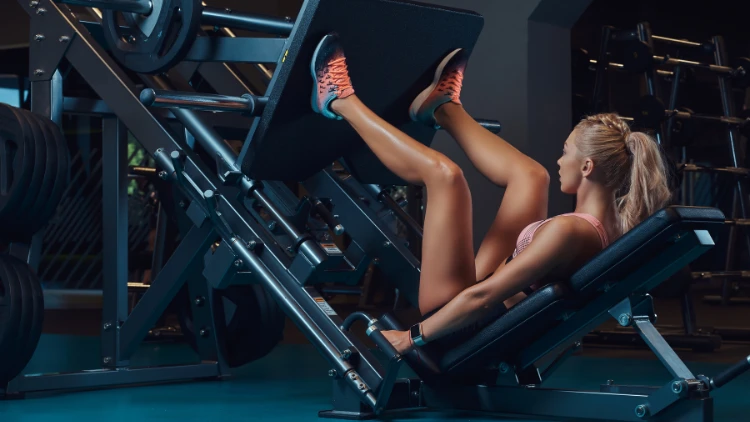
Source: FXQuadro via Canva.com14
The high foot placement impacts one’s hamstrings and glutes, while adding the wide stance brings more activation to the hips as well.
It can be easy for the feet to slip and slide completely off of the foot plate in this position, so anyone attempting it should make sure that both feet are completely flat, fully on the sled, and are not too close to the edge.
9. Low & Narrow Placement: The low and narrow combination of foot placements requires the feet to be placed just inches apart from each other near the bottom of the foot plate, but–as always–still flat and fully on the sled.
This dynamic duo of low and narrow will really hone in on the quads and is a great stance for enhancing hypertrophy in these muscles.
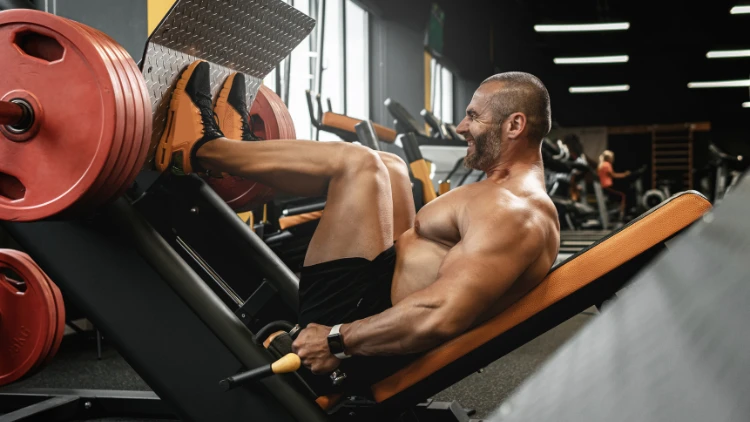
Source: A’s Images via Canva.com15
An important warning to anyone with prior knee injuries or ongoing knee pain: it is highly advised to stay away from this foot placement combination, as the immense pressure put on the knees in this stance can quickly turn from a great quad burner to a much more serious knee issue.
Those with knee troubles or concerns can certainly hit the quads sufficiently with alternative foot placements without the heightened risk of an injury or worsened pain.
Best Foot Placement for Glutes During Leg Press: High & Wide Foot Placement
A lot of sitting or inactivity can cause muscle loss and weakness in the glutes and can even lead to atrophy and a decreased range of motion if not exercised properly and regularly, so really targeting the glutes is an important feature of the leg press.
Working the glutes will not only keep one’s muscles active and flexible, but also allows for more strength as well as better balance and mobility.
The optimal foot placement on leg press for glutes is the combination of high and wide foot positions. Both the high and wide stances target the glutes individually, so integrating the two makes this the supreme position for glute gains in both strength and size.
Anyone who gives this pair of foot placements a try will attest to how much they can feel the increased focus on and burn in the glutes. The hamstrings and hips will both benefit from this foot placement as well.
Those wanting even more emphasis on their glutes can slightly angle their feet and toes outward and work on deeper movements with each rep, always remembering to keep feet flat on the foot plate.
Best Leg Press Foot Placement for Quads: Lower Position
The optimal foot placement for quads on leg press is a low stance with the feet close together in a narrow position. Since this position vastly restricts the range of motion throughout the leg and also limits mobility in the hips, the quad muscles must in turn be activated even more to be able move the weighted sled back and forth.
Someone adhering to the lower foot placement may also notice that they can actually lift more in this foot position, as less distance is covered so their legs will not fatigue as quickly during each rep or set.
Since quad muscles help to walk, kick, jump, and run, this specific foot placement is extremely useful in increasing strength, hypertrophy, and especially mobility.
Although this low and narrow foot position on leg press brings the most quadricep activity during leg press exercise, someone interested in giving it a try should recall that the knee is also more prone to injury or pain in this stance, so those with previous knee issues should get their quad workout in through another foot placement or routine.16
What Muscles Are Targeted in the Leg Press?
Impressively, the leg press gives significant attention to the glutes, hamstrings, and the quads in most of the foot position variations, but even the calves and hips can be activated through certain foot placements.
Muscles targeted in the leg press include:
- Glutes (gluteus maximus, gluteus medius, gluteus minimus)
- Quads (rectus femoris, vastus intermedius, vastus medialis, vastus lateralis)
- Hips (tensor fasciae latae, iliacus)
- Hamstrings (semitendinosus, semimembranosus, biceps femoris)
- Calves (gastrocnemius, soleus, plantaris)
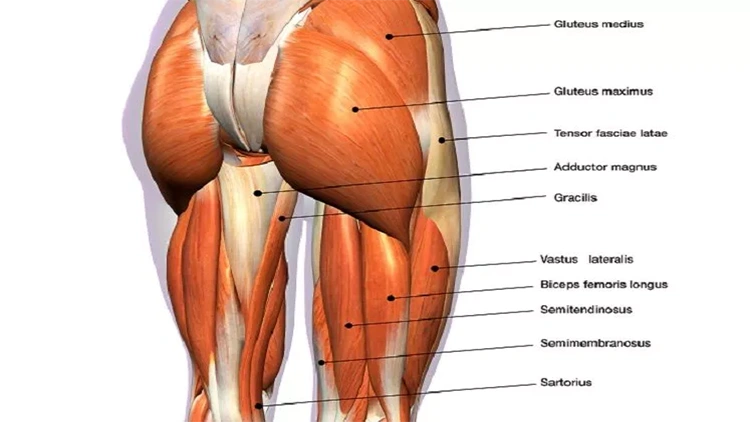
Source: Sarah Knapp via Biology Dictionary17
Stretching and strengthening the knee are crucial for leg press enthusiasts, as unaddressed knee problems can significantly impact performance and safety on the machine.
However, those without knee issues are able to work every major muscle group in the legs and throughout the posterior chain without hesitation on the leg press machine.
Given the engagement of numerous muscles and muscle groups during leg press exercises, this machine can be a valuable addition to any workout routine plan, facilitating rapid strength and muscle mass gains. It can be easily adjusted for different levels of volume, intensity, and experience.
Leg Press Tips & Tricks
Pre-exhaust sets: By preceding the leg press with an intensive squat routine, one can maximize their leg gains by targeting certain muscles in isolation as well as then including them in a compound workout. These can be crucial to skyrocketing leg gains from mediocre to incredible.
Even transitioning between the standard foot placement and an alternate placement or combination such as the low and narrow stance will replicate a pre-exhaust set on a smaller scale, all on one machine.
Periodization: Implementing periodization can greatly enhance your gains, and it’s easily adaptable to the leg press, providing structure and clarity to your strength routine. The effects of periodization on strength and muscle hypertrophy are proven to lead to greater increases in strength than those who do not follow a periodized routine.18
Use slow, controlled, and smooth motion: A note for beginners–trying to add speed or making more jerky movements is a recipe for disaster on the leg press machine. Proper form and using the machine as it was meant to be used will prevent many mistakes and easily avoidable injuries.
Never lift your back off of the seat: The backrest on the leg press machine is meant to be used and offers great back stability, so not using it properly or without the full length of your back makes the likelihood of a risky slip or injury much higher.
Be aware of which muscles are not activated: One final word of advice, in relation to the prior tip: the leg press offers an amazing lower body workout, but the lower back is hardly used on this machine.
Be sure to preface or follow up the leg press with some other exercises that engage the lower back and, of course, the entire upper body too.
Common Mistakes Made on the Leg Press & How To Avoid Them
After discussing leg press foot placements and providing tips for optimal results, let’s now briefly review several common mistakes made during leg press exercises and how to avoid them.
The leg press is an excellent exercise for lower body mobility and stretching, but it can lead to painful injuries due to simple mistakes or misconceptions. Simply educating oneself on proper usage and common mistakes can help protect them during this routine.
1. Lowering the sled too far: This will round the butt and lower back, pulling them out of the proper position and off of the backrest, making the lumbar spine instantly more prone to injury such as a slipped disc. Maintain controlled movements and do not bring the knees all the way up to the chest.
2. Shallow reps: While not necessarily dangerous, shallow repetitions or movements are just not very effective and will not bring the desired strength or size gains. A much larger range of motion can and should be used, with slow but deep leg movements.
3. Heels off the edge of the foot plate: One of the easiest mistakes to make is being careless or distracted and allowing one or both feet to slip off of the sled, especially when the toes alone are pushing all of that weight.
However, one can imagine how dangerous this minor slip could be, as the full weight sled will immediately lose all resistance and drop. This tendency to let the heels hang over the edge of the foot plate is exacerbated by the wide range of sizes that leg press machine foot plates come in.
Some have plenty of surface area for a really wide stance, but other sleds may be much smaller in size and will not accommodate for as much room. This increases the need for constant awareness of foot placement and always being conscious of keeping one’s heels in check when doing this routine.
Anyone using this machine must always be on high alert, ensuring that both of their feet are constantly flat against the plate and away from all edges of the sled to maintain proper form and control.
4. Knees pointing inward: The knees should stay about as separated as the feet are on the foot plate; this will not only properly work the leg muscles as intended, but also serves to prevent unnecessary knee soreness or aggravation that may come from the knees being pointed inward.
Weakened hip abductors create the tendency to allow the knees to lean or collapse inwards, but with ACL tears extremely common in this position, it is much better to keep the knees properly aligned than to have to deal with such an extreme consequence of being too lax on knee form.
Strengthening the glutes by doing lunges or other glute-centered exercises can help prevent this tendency, as can spending more time on the abductor machine.
5. Too much weight: Overloading the leg press with weight too excessive for the legs to support can crush someone’s knees to their chest or at least cause a severe strain from overworking hamstrings, quads, or other muscles.19
To prevent this, someone unsure of how much weight to add should always start out with solely the leg press machine itself and, if not challenging enough, can slowly add weight plates until the desired amount is reached.
Another potential issue with loading too much weight on the machine is that the person using it may be able to hold the weight up, but will likely only be able to move it successfully a few inches back and forth.
This small amount of movement will hardly work any muscles as it has very little range of motion, so the user is not really reaping any benefits of the leg press if the machine is loaded improperly like this.
6. Locking knees: Though it’s easy to do, anyone who has made the painful mistake of locking their knees on the leg press machine likely won’t make that same mistake twice; locking the legs can lead to drastically and excruciatingly hyper-extending the knee or even popping the knee out in the opposite direction.
Additionally, stretched hamstring injuries are caused by extreme flexion of the hips while the knee is fully extended, so anyone using the leg press should be especially aware of these risks and take proper safety precautions to avoid these unnecessary risks.20
Keeping a reasonable weight on the machine and a slight bend in the knees even at full extension will prevent this painful outcome.
Actually, full extension can even be foregone by those with knee problems, as reaching about 90% extension will still give the targeted muscles a great workout without risking added knee injury.
7. Feet pointed excessively inward or outward: While it may feel natural to angle the toes slightly in or out, doing so to a great degree can cause decreased effectiveness of the leg press at best, and make someone more likely to be hurt at worst.
As is the case with many other common mistakes, the lifter is especially vulnerable to knee strain or damage when the feet are rotated too far in or out. Instead, those utilizing the leg press machine are best suited keeping their feet vertically aligned or only turned in or out to a minor degree.
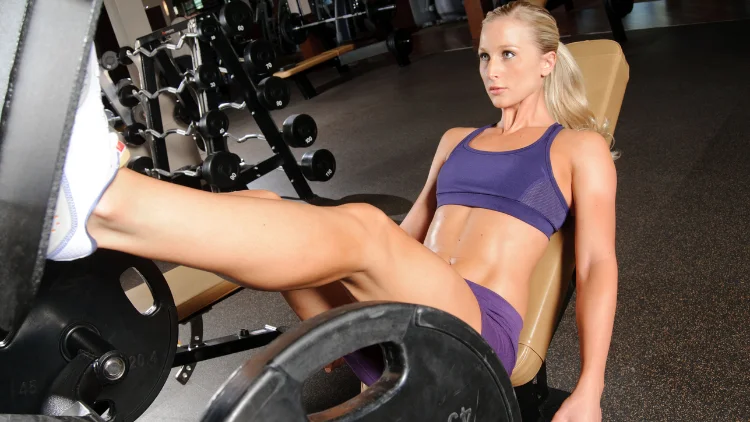
Source: msderrick via Canva.com21
While beginners might begin with a basic or neutral stance, advanced lifters can choose to continue with this position or experiment with other leg press foot placements to effectively target specific muscles and enhance muscle building and strength gain throughout the lower body.
Frequently Asked Questions
What Variations Can Be Performed on the Leg Press?
Beginners are advised to maintain the standard foot placement on the leg press machine until proper form and controlled movements are well understood and practiced, but those on intermediate powerlifting programs or with more advanced lifting experience may want to experiment with various foot placements, try the single leg press, or alter the angle used (i.e. switching from the horizontal to the inclined or vertical leg press).
Which Foot Position on Leg Press Works the Most Muscles at Once?
The basic foot placement is perfect for a general workout and plenty of muscle recruitment as it activates the hamstrings, the glutes, and the quads.
While this standard foot placement provides an overall well-rounded routine, a high and wide combination of foot positions will serve to engage the glutes, hamstrings, and hips for another compound and dynamic exercise.
Can the Leg Press Be Adapted To Use Despite Injuries?
The leg press machine can be used if injured and is even used often in physical therapy, but considerations should be made for the best adaptations based on the type of injury and its severity.
Again, these will vary dependent upon the injury, person, and pain level, but a few options for adapting the leg press routine include slight outward rotation or angling of the feet for greater comfort, reclining the back rest slightly further or moving the entire seat back somewhat for low back pain issues, and raising feet higher on the foot plate for those with pre-existing knee pain or a knee injury. Anyone with knee issues should avoid low foot placement altogether.
What Types of Leg Press Machines Are the Best?
Angled machines position the user’s back at an approximately 45-degree incline. This version is very common in commercial and even home gyms, is excellent for focusing on muscle growth, and slides on a fixed path with added safety features to protect the user.
The seated leg press, sometimes called the cable press, is pushed horizontally and is best for single leg presses. This is an older version with few safety features but is still widely used and since the weight is being moved in front of the lifter (instead of above, as on the angled or vertical machines), there is little to no risk of injury if the feet slip off of the foot plate.
The vertical leg press tends to be much less commonly found, but requires the lifter to lay flat on their back and push the weight up into the air. Though this allows lifting of “true weight”, it is much more dangerous and is not advised for beginners.
Should I Point My Toes in or Out on the Leg Press?
There is no correct or universal answer to this; it completely depends on the lifter and even on the general foot placement for the leg press.
For those with retroverted hips or pre-existing injuries, a slight outward-facing rotation is okay. Whichever toe and foot position is most comfortable for the user and allows for the greatest ROM is allowed and advised.
Does the Leg Press Toe Angle Affect the Muscles Worked?
Toe angles can impact the leg muscles worked, as they are all connected. The most likely effect will be the added engagement of either the abductors or adductors, depending on the toe and foot angle, but other muscles can be influenced as well depending on foot position and to what degree the feet are angled.
Which Is Better: Leg Presses vs Squats?
This is another catch 22 without a clear answer, as each has its own strengths and best features. One thing to note, however, is that those who have previous back injuries or lower back pain are recommended to forego their squat routine and instead utilize the leg press machine, as it stabilizes the back while still providing a solid leg workout.
The beginner’s guide to strength training gives plenty more insight for novices.
References
1Wikipedia, the Free Encyclopedia. (2022, May 12). Leg press. Wikipedia. Retrieved January 20, 2023, from <https://en.wikipedia.org/wiki/Leg_press>
2leezsnow. “Health Club Workout – Leg Press.” Canva. Accessed 14 April 2023. <https://www.canva.com/photos/MAED9cZvbPg-health-club-workout-leg-press/>
3Lerner, A. (2023). Knee Flexion Mechanics. University of Rochester. Retrieved January 20, 2023, from <https://www.hajim.rochester.edu/bme/research/knee-flexion-mechanics.html>
4gilaxia. “Leg press exercise.” Canva. Accessed 14 April 2023. <https://www.canva.com/photos/MAEJfs1S9eE-leg-press-exercise-/>
5Escamilla, R., Fleisig, G., Zheng, N., Lander, J., Barrentine, S., Andrews, J., Bergemann, B., & Moorman, C. (2001, September). Effects of technique variations on knee biomechanics during the squat and leg press. National Institute of Health. Retrieved January 20, 2023, from <https://pubmed.ncbi.nlm.nih.gov/11528346/>
6Shah, N. (2008, May). Increasing Knee Range of Motion Using a Unique Sustained Method. National Institute of Health. Retrieved January 20, 2023, from <https://www.ncbi.nlm.nih.gov/pmc/articles/PMC2953321/>
7bulatovic. “Leg press exercise.” Canva. Accessed 14 April 2023. <https://www.canva.com/photos/MADEQCYtWD0-leg-press-exercise-/>
8Da Silva, E., Brentano, M., Cadore, E., De Almeida, A., & Kruel, L. (2008, July). Analysis of muscle activation during different leg press exercises at submaximum effort levels. National Institute of Health. Retrieved January 20, 2023, from <https://pubmed.ncbi.nlm.nih.gov/18545207/>
9Scott Webb. “Woman Using Leg Press Machine.” Canva. Accessed 14 April 2023. <https://www.canva.com/photos/MADGx2PwceM-woman-using-leg-press-machine/>
10Dusan Ilic. “Woman doing leg press.” Canva. Accessed 14 April 2023. <https://www.canva.com/photos/MAEFALnlVSU-woman-doing-leg-press/>
11Minerva Studio. “Leg press.” Canva. Accessed 14 April 2023. <https://www.canva.com/photos/MAC9c6QWYCg-leg-press/>
12Hislop, H., Montgomery, J., & Connelly, B. (1995). Manual Muscle Testing of the Knee. University of West Alabama. Retrieved January 20, 2023, from <http://at.uwa.edu/mmt/knee.htm>
13bluecinema. “Woman exercising on leg press in gym.” Canva. Accessed 14 April 2023. <https://www.canva.com/photos/MAEEtC7Yq-M-woman-exercising-on-leg-press-in-gym/>
14FXQuadro. “Athletic blonde woman in sportswear doing exercise on the legs press machine in the gym.” Canva. Accessed 14 April 2023. <https://www.canva.com/photos/MADCjI_QpFU-athletic-blonde-woman-in-sportswear-doing-exercise-on-the-legs-press-machine-in-the-gym-/>
15A’s Images. “Bodybuilder Doing a Seated Leg Press Exercise in a Gym.” Canva. Accessed 14 April 2023. <https://www.canva.com/photos/MAE2-gMUdmQ-bodybuilder-doing-a-seated-leg-press-exercise-in-a-gym/>
16Machado, W., Paz, G., Mendes, L., Maia, M., Winchester, J., Lima, V., Willardson, J., & Miranda, H. (2017, February). Myoeletric Activity of the Quadriceps During Leg Press Exercise Performed With Differing Techniques. National Institute of Health. Retrieved January 20, 2023, from <https://pubmed.ncbi.nlm.nih.gov/28129279/>
17Knapp, Sarah. “Hip Muscles – The Definitive Guide.” Biology Dictionary, 27 June 2020. Accessed 16 April 2023. <https://biologydictionary.net/hip-muscles/>
18Moesgaard, L., Beck, M., Christiansen, L., Aagaard, P., & Lundbye-Jensen, J. (2022, July). Effects of Periodization on Strength and Muscle Hypertrophy in Volume-Equated Resistance Training Programs: A Systematic Review and Meta-analysis. National Institute of Health. Retrieved January 20, 2023, from <https://pubmed.ncbi.nlm.nih.gov/35044672/>
19Harvard Medical School. (2019, January 1). Are your hamstrings working double duty? Harvard Health Publishing. Retrieved January 20, 2023, from <https://www.health.harvard.edu/staying-healthy/are-your-hamstrings-working-double-duty>
20Danielsson, A., Horvath, A., Senorski, C., Alentorn-Geli, E., Garrett, W., Cugat, R., Samuelsson, K., & Senorski, E. (2020, September 29). The mechanism of hamstring injuries – a systematic review. National Institute of Health. Retrieved January 20, 2023, from <https://pubmed.ncbi.nlm.nih.gov/32993700/>
21msderrick. “Leg Press Female.” Canva. Accessed 14 April 2023. <https://www.canva.com/photos/MAEJHKuHpMQ-leg-press-female/>